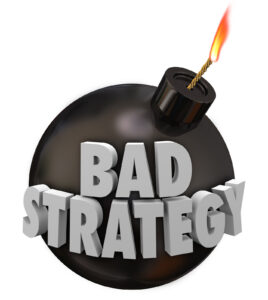Know as Strategy Strategist Richard Rumelt speaks powerfully regarding how Strategy’s primary objective is finding a path to overcoming obstacles a business faces. He emphasizes that Strategy focuses a firm’s resources and capabilities against opportunities. In contrast, today, what is thought to be Strategy is instead a combination of ambitions, desires, fluff, and buzzwords mashed up to sound intelligent.
“Fluff is superficial restatement of the obvious combined with a generous sprinkling of buzzwords.”
Richard P. Rumelt
On a recent podcast episode of Inside the Strategy Room by McKinsey & Co, Rumelt dives deep into what separates good Strategy from bad. He emphasizes a recent trend towards bad Strategy as CEOs, executives and boards copy what they see others doing. For Rumelt, many so-called strategies are actually a list of ambitions and desires, not strategies. Ambitions and desire feed and inspire your vision and mission, but not your strategy. Strategy is problem-solving, and Strategy is overcoming obstacles and barriers faced by businesses.
“Many bad strategies are just statements of desire rather than plans for overcoming obstacles.”
Richard Rumelt
Rumelt reminds us that if what we are doing is easy, it probably is not Strategy. Strategy is complex; it requires making choices and commitments that leave things behind. These choices and decisions are what make good Strategy so hard. Many Executives believe that Strategy must include everyone, but Strategy is not a democratic process. Traditional Strategy focuses on Product/Market performance along with Customers and Competition. It emphasizes the numbers and financials rather than understanding the problem. Leaders commit resources where they have a competitive advantage to increase market share or sales revenue. Strategy done in this manner leaves out Organizational Functioning and other inward-facing challenges a business faces. Many times these obstacles are just as significant as those of your competitors.
Strategy is about what is important and what challenges you face! Not just about products and services. A Strategy must be focused to be effective and achieve the results desired. Strategy must be challenge-based, not goal based. If your problem were easy to solve, you or your competitor would have done it already. All stakeholders must get honest and talk about what people don’t want to discuss.
A good Strategy must have a response to these questions:
What’s wrong?
What has gone well?
What are the challenges we face?
What are the big opportunities?
What are the obstacles?
What’s failing? What’s not working?
Why do some customers choose our competitors?
What problems and challenges can you make progress on; commit and make an action plan. Like a physician diagnosing a patient, stakeholders must first diagnose their business’s problems and challenges. For an organization to expend valuable time and resources on a problem, the problem must be:
1. important, and
2. capable of being solved.
Realize that maybe the thing we thought was a problem wasn’t a problem to be solved (because problems have solutions); maybe it was simply a situation or even a dead end.
“A good strategy honestly acknowledges the challenges being faced and provides an approach to overcoming them.”
Richard P. Rumelt
Rumelt talks about “The Crux,” the most challenging part of a mountaineer’s climb, in his most recent book with the same title. Don’t climb if you can not handle The Crux. Similarly, with Strategy, don’t tackle a problem if you can not handle the most challenging part, and every problem has a hard part. Strategy is best formulated by those that know the business best, the CEO, Managers, and Stakeholders. Outsiders and consultants focus on what they all understand best, Financial Accounting and Financial Statements. This emphasis on the financials slants Strategy and goals to numbers rather than obstacles and problems.
Your summary and takeaways.
Strategy does not require sorting through the differences between visions, missions, goals, strategies, objectives, and tactics. It does not require that Strategy be split between corporate, business, and product levels.
Rumelt states the “kernel” of Strategy contains three elements:
1. A diagnosis that defines the challenge or obstacle.
2. A guiding policy for dealing with or overcoming a challenge or obstacle.
3. A set of coherent actions designed to carry out the guiding policy.
So how does your Strategy compare? Do you have a good strategy? or do you need to reevaluate, recraft and redirect your resources to achieve the desired results?
References for the interested reader:
https://www.goodreads.com/book/photo/11721966-good-strategy-bad-strategy
https://www.goodreads.com/book/show/58895961-the-crux




0 Comments